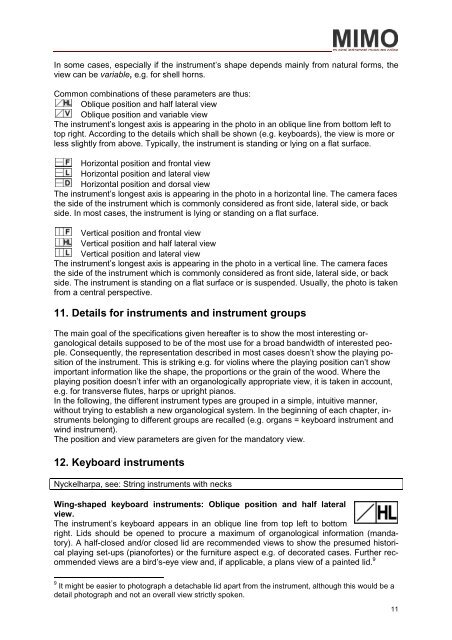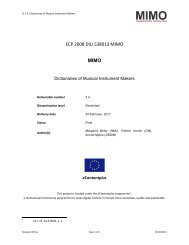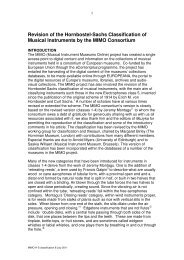MIMO Digitisation Standard
MIMO Digitisation Standard
MIMO Digitisation Standard
- No tags were found...
Create successful ePaper yourself
Turn your PDF publications into a flip-book with our unique Google optimized e-Paper software.
In some cases, especially if the instrument’s shape depends mainly from natural forms, theview can be variable, e.g. for shell horns.Common combinations of these parameters are thus:Oblique position and half lateral viewOblique position and variable viewThe instrument’s longest axis is appearing in the photo in an oblique line from bottom left totop right. According to the details which shall be shown (e.g. keyboards), the view is more orless slightly from above. Typically, the instrument is standing or lying on a flat surface.Horizontal position and frontal viewHorizontal position and lateral viewHorizontal position and dorsal viewThe instrument’s longest axis is appearing in the photo in a horizontal line. The camera facesthe side of the instrument which is commonly considered as front side, lateral side, or backside. In most cases, the instrument is lying or standing on a flat surface.Vertical position and frontal viewVertical position and half lateral viewVertical position and lateral viewThe instrument’s longest axis is appearing in the photo in a vertical line. The camera facesthe side of the instrument which is commonly considered as front side, lateral side, or backside. The instrument is standing on a flat surface or is suspended. Usually, the photo is takenfrom a central perspective.11. Details for instruments and instrument groupsThe main goal of the specifications given hereafter is to show the most interesting organologicaldetails supposed to be of the most use for a broad bandwidth of interested people.Consequently, the representation described in most cases doesn’t show the playing positionof the instrument. This is striking e.g. for violins where the playing position can’t showimportant information like the shape, the proportions or the grain of the wood. Where theplaying position doesn’t infer with an organologically appropriate view, it is taken in account,e.g. for transverse flutes, harps or upright pianos.In the following, the different instrument types are grouped in a simple, intuitive manner,without trying to establish a new organological system. In the beginning of each chapter, instrumentsbelonging to different groups are recalled (e.g. organs = keyboard instrument andwind instrument).The position and view parameters are given for the mandatory view.12. Keyboard instrumentsNyckelharpa, see: String instruments with necksWing-shaped keyboard instruments: Oblique position and half lateralview.The instrument’s keyboard appears in an oblique line from top left to bottomright. Lids should be opened to procure a maximum of organological information (mandatory).A half-closed and/or closed lid are recommended views to show the presumed historicalplaying set-ups (pianofortes) or the furniture aspect e.g. of decorated cases. Further recommendedviews are a bird’s-eye view and, if applicable, a plans view of a painted lid. 99 It might be easier to photograph a detachable lid apart from the instrument, although this would be adetail photograph and not an overall view strictly spoken.11





